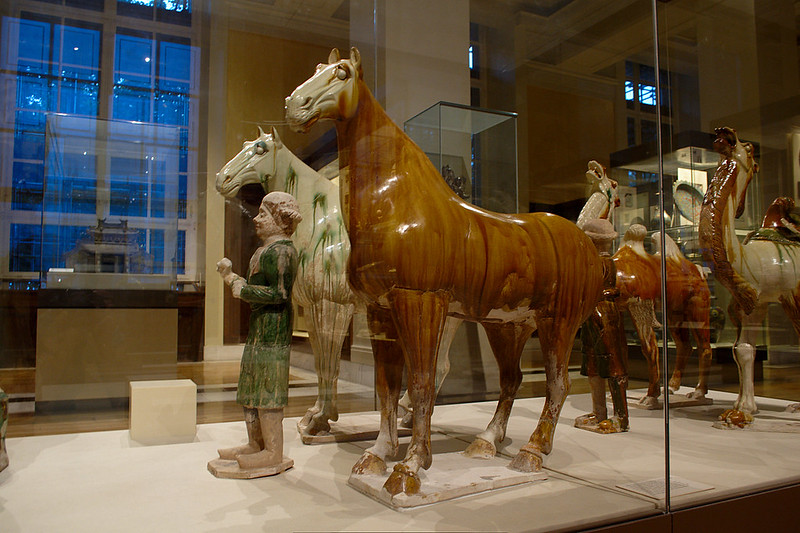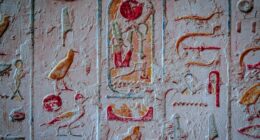The Tang dynasty is known for its military prowess, cultural achievements, and advancements in trade and commerce. Meanwhile, the Song dynasty is acknowledged for its developments in science, art, literature, and technology.
The Tang Dynasty
(Photo By Margaret Lucy Patterson on Flickr)

The Tang Dynasty was one of the most prosperous and influential periods in Chinese history, lasting from 618 to 907 AD. During this time, China experienced a golden age of culture, art, literature, and technology.
Under the Tang Dynasty’s rule, China expanded its territory to include parts of Central Asia and Korea. The dynasty also established strong diplomatic ties with neighboring countries such as Japan and India.
The Tang Dynasty is famous for its advancements in science and technology. They invented gunpowder, paper money, block printing techniques that greatly influenced book production all over the world.
Additionally, the arts flourished during this period with many notable poets like Li Bai emerged whose poetry is still celebrated today. Calligraphy also reached new heights of beauty under Tang artists who used intricate brush strokes to create stunning works of calligraphy.
The Tang Dynasty left an indelible mark on Chinese civilization which can still be seen today through cultural traditions like music,dance costumes,and architecture.
The Song Dynasty
(Photo By Gary Todd on Flickr)

The Song Dynasty, which lasted from 960 to 1279 CE, was a period of great cultural and technological advancements for China. During this time, the Chinese invented movable type printing and paper money, both of which revolutionized communication and commerce throughout Asia.
In addition to these innovations, the Song Dynasty is also known for its thriving economy and trade networks. The Grand Canal allowed goods to be transported easily between northern and southern China while overseas traders brought exotic goods like spices, silk, and porcelain.
The arts flourished during this time as well with notable achievements in poetry, calligraphy, painting, and ceramics. Neo-Confucianism became the dominant philosophy in China during this era too.
Despite its many accomplishments though, the Song Dynasty suffered from political instability towards the end of its reign. It faced invasions by Mongol armies led by Genghis Khan’s grandson Kublai Khan who eventually conquered all of China leading to the Yuan Dynasty.
Though despite its downfall in history books The Song dynasty remains one of most celebrated eras not only because it marked an important period for art but also innovation that still holds impact today especially within technology fields.
The tang dynasty and The song dynasty – Key differences
The Tang Dynasty and the Song Dynasty were two of the most prominent dynasties in China’s history. Although both reigned over a prosperous period, they differ significantly from each other.
Firstly, the Tang Dynasty was known for its military prowess and expansionist policies. On the contrary, the Song dynasty focused on strengthening their economy through trade and innovation.
Secondly, during the Tang Dynasty era, Buddhism played an essential role in shaping Chinese culture. Comparatively speaking, Confucianism was at its peak throughout The Song dynasty.
Thirdly, when it comes to artwork and literature, while The Tang dynasty gravitated towards more realistic depictions of nature and people; The Song dynasty preferred more elegant pieces that conveyed emotions rather than just appearance.
Although both dynasties are famous for their technological advancements – like gunpowder – it is notable that printing technology reached new heights under The Song Dynasty.
Though similar in certain aspects such as prosperity and innovative progressions; differences between these two dynasties exist concerning governance policies along with cultural beliefs leading to unique characteristics contributing massively to China’s rich history.
Why the Tang Dynasty is considered better than the Song Dynasty
The Tang Dynasty is widely regarded as one of the most prosperous periods in Chinese history. It lasted from 618 to 907 AD and was characterized by its achievements in art, literature, technology, military campaigns and diplomacy. Here are some reasons why the Tang Dynasty is considered better than the Song Dynasty:
Firstly, the Tang Dynasty had a much larger territory compared to that of the Song dynasty. The Tang Empire stretched from Xinjiang in western China to Korea in eastern Asia.
Secondly, during this period there were significant advances made in various fields including astronomy, mathematics and medicine which helped shape modern day scientific knowledge.
Thirdly, under Emperor Xuanzong’s reign (713-756), economic prosperity flourished with a stable currency system leading to increased trade routes within Asia.
Fourthly, the Tang dynasty saw great strides taken toward equality for women – they could become educated and hold positions of power such as imperial consorts or even Empress!
Lastly but not least important ,the culture that emerged during this era inspired artists throughout time with its intricate artwork depicting landscapes or scenes from everyday life alongside calligraphy on silk scrolls known as shuimo paintings. All of these factors combined make it clear why many historians consider The Tang Dynasty superior when compared against other dynasties like The song dynasty
What were the Tang and Song dynasties known for?
The Tang Dynasty, which lasted from 618 to 907 AD, is known for its great achievements in art and literature. During this period, many poets emerged with some of the most famous poems in Chinese history. The Tang Dynasty also had a strong economy due to their successful Silk Road trade.
On the other hand, the Song Dynasty (960 -1279 AD), was known for its technological advancements such as gunpowder, printing press and movable type. They developed a strong navy and created innovative agricultural techniques resulting in a boom in population growth.
Both dynasties made significant contributions to Chinese culture but were vastly different from one another. While the Tang dynasty focused more on arts and literature, the Song dynasty’s focus was mainly scientific development.
Notably, both dynasties were responsible for building grand monuments that still stand today; examples include The Great Wall of China built during the Tang dynasty while Hangzhou’s West Lake dates back to the Song era.
It can be said that both dynasties left their mark on Chinese history in unique ways that will always remain noteworthy.
Who was the greatest ruler of China?
China has had many great rulers throughout its history, but one of the most prominent and revered is undoubtedly Emperor Taizong of the Tang Dynasty. He is considered by many to be one of the greatest emperors in Chinese history due to his intelligence, military prowess, and his contribution to China’s cultural and economic development.
During his reign from 626-649 AD, Emperor Taizong expanded China’s borders through successful military campaigns against neighboring kingdoms while also promoting trade with other countries. He was known for being a just ruler who listened to the opinions of his advisors before making decisions that benefited both himself and his people.
Emperor Taizong also encouraged education and scholarship by establishing schools throughout China. This resulted in an increase in literacy rates among commoners which helped facilitate widespread communication across different regions.
His contributions were not limited to political or military conquests as well; he promoted art and culture during his rule. Literature flourished under him due to advancements in printing technologies which allowed more books to be produced at a lower cost. Additionally, music thrived under him as Tang Dynasty musicians experimented with new sounds.
It is clear why Emperor Taizong continues to be celebrated today – he was able to maintain peace while expanding territory all while fostering a sense of intellectual curiosity among citizens.
Which dynasty ruled the longest?
The duration of a dynasty’s reign is often an important indication of its success and stability. In the case of China, two dynasties stand out for their exceptionally long rule: the Zhou Dynasty and the Qing Dynasty.
The Zhou Dynasty ruled China for an impressive 800 years from 1046 BC to 256 BC. It was during this time that many significant cultural and philosophical developments took place in China, including the emergence of Confucianism and Taoism.
However, it should be noted that the authority of the Zhou rulers declined significantly towards the end of their reign, which paved the way for new powers to emerge in China.
Moving on to more recent Chinese history, we have the Qing Dynasty. This dynasty began its rule in 1644 AD after overthrowing its predecessor -the Ming Dynasty- and continued until 1912 with a total reign length of almost three hundred years.
During this period, significant events occurred such as population growth mainly due to economic expansion through trade; however corruption within government officials led to financial crisis near end-of-reign leading eventually into revolution against them by republicans forces supported by various other factions wanting change or independence from imperialist Chinas’ hierarchy.








